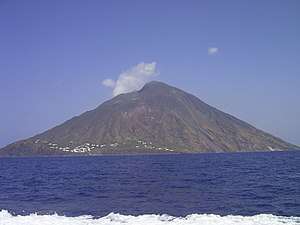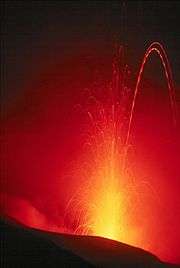Stromboli
Stromboli is a very small Italian volcanic island in the Tyrrhenian Sea just north of Sicily. It is one of the Aeolian Islands.

The island of Stromboli is little more than just the 900 m high volcano itself and thus has a very small size of only 12.6 square kilometres. Two kilometres northeast of Stromboli is the small, uninhabited sister island Strombolicchio.
The volcano was notably featured in the famous novel by Jules Verne, Journey to the Centre of the Earth (French: Voyage au centre de la Terre), and was where the protagonists exited the bowels of the earth after making the underground journey all the way from Snæfellsjökull in Iceland.
Understand
Stromboli is a fully active volcano that is in a constant state of mild activity, punctuated by occasional larger and more violent eruptions. The most recent violent interruption that has caused the closure of the summit area was from August to October 2014 ; see infobox below for more details.
Though the "normal" small eruptions of lava are not dangerous, you should be aware of the possible danger. The local authorities are very aware of Stromboli's state, so listen to them. If paths to the craters are closed, don't go there. Never climb up the volcano without a local guide. Don't leave paths.
Tours up the Stromboli aren't easy walks. Uphill approx. 900m altitude difference in 3 hours. Downhill - on mostly sandy ground - 2 hours. You should be well-equipped (climbing boots, min 1.5 liters of water and a flashlight with enough battery capacity), healthy and in good physical condition when going there.
As Stromboli is small and its environment is sensitive, you should treat it carefully. Climbing boots can be rented at guide services and shops.
Also in the villages take a flashlight (torchlight) along with you, as the streets are not illuminated.
Villages
There are two villages on the island: the larger Stromboli and the much smaller Ginostra, a former fishing village rarely visited by tourists (although tourist services are about all that remains there). It is not yet feasible to walk between the villages (although a trans-island hiking trail is under construction as of 2007), and the only way to travel between them is by boat. Together, both villages only have about 350 inhabitants.
Get in

Access is by boat, there being no place on the island to put an airport. The hydrofoil and ferry operators SNAV, SIREMAR, Ustica Lines, and NGI all connect Stromboli village and Ginostra to other points in the Aeolian Islands and to Sicily, Naples and other parts of the mainland. You may have to change boats in Lipari. Don't even think of bringing a full-sized car with you, as you'll have no place to use it. Consequently, it's highly advantageous to ride the fast hydrofoil rather than a ferry. The shortest (1.5 hours) and cheapest (about 30 EUR in 2015) water route is with Comerci Navigazione from Tropea where also a night train (with sleeping carʂ) from Rome stops.
Get around
Due to the size of the island and its lack of streets, neither cars, buses nor trains exist. The only available means of transport are "ape-cars", small motorbikes and boats (luckily battery powered cars and bikes are on the rise). The only other way to move around the island is by walking. Note that there are no streetlights in either village, and if you're out after dark, you'll be well advised to use a flashlight.
See
- The villages, which are almost unchanged by tourism, are worth a closer look, especially the rather hidden Ginostra with the smallest European port (one boat only!) of all is nice to see.
- There is a nice beach with fine black lava sand in Stromboli, where one can relax and swim in the sea.
Do
|
Strombolian eruptions Stromboli gives its name to a type of volcanic eruption that's frequent, visually spectacular, and fairly safe to approach -- most of the time. "Strombolian eruptions" are characterized by nearly continuous emission of blobs of lava shot a small distance into the air as "fire fountains" like the one shown in the accompanying image. They're seen to best advantage at night, and a camera capable of timed exposures of several seconds is required to get the most interesting photos. These eruptions are usually viewable in complete safety from the crater rim. However, every few years a more energetic eruption occurs, taking the form of either a lava flow down the Sciara del Fuoco (a collapse feature on the north side of the island) or brief but violent explosions from the summit that propel rocks beyond the crater, sometimes causing minor damage in Stromboli village or Ginostra. These events obviously are hazardous, and furthermore, for some months after a lava flow or explosive event, activity at the summit crater becomes more explosive -- and less scenic, as the magma column is well below the crater rim. As of October 2014, the volcano has settled down from the more unstable state that characterized it from August 2014 on, but inquire locally about access anyway. |
Most visitors to the island come to climb (or at least hike on) Stromboli Volcano. However, other opportunities for outdoor recreation exist.
- Stromboli Volcano. This continuously active volcano is one of the few in the world where a visitor can see an eruption "up close and personal," yet in relative safety -- most of the time. However, conditions vary from year to year, and the summit region may be closed (as it was August to October 2014) owing to unusual activity posing hazards to the climber. In most conditions you can hike unaccompanied to an elevation of 400 meters, but beyond this level you will need a guide. A reliable guide service is Magmatrek, Via Vittorio Emanuele, +39 090 9865768, , but there are other guide services in town that are also satisfactory. Don't climb without a guide; the access limitations are enforced (sporadically) and fines are substantial.
- Take a boat ride around the island. The picturesque little village of Ginostra is on the opposite side of the island from Stromboli town and is only reachable by boat. Outfitters near the harbor in Stromboli town offer rides, which can usually be arranged on site.
- Scuba diving is possible at the small island of Strombolicchio, offshore from Stromboli town. The water is very clear, and you can see the continuation of the volcanic plug comprising Strombolicchio far below the surface. Dry-land activities on Strombolicchio are generally not allowed as the island is a nature preserve. Lighthouse on top.
- Canoeing and Stand Up Paddling (SUP) around the island to interesting places like the Sciara del Fuoco, Piscina a natural swim bassin and Strombolicchio is possible. It offers the opportunity to stay on the sea without the noise of a motor and even hear the rumbling of the vulcano. One friendly service is Centro Mare.

Eat
- Pizzeria Punta Bronzo, Via Acquaro Antonino, ☎ +39 090 986013. At the foot of one of the trails to the 400-meter platform at the Sciara del Fuoco. Food is nothing special, but entirely serviceable, and the setting is highly atmospheric.
- Trattoria Ai Gechi, Via Mirabito Giuseppe (Up a steep hill from the downtown area of Stromboli village), ☎ +39 090 986213. Daily 7:30PM-2AM in August; daily 12:30-2:30PM and 7:30PM-2AM in all other months. "Mediterranean" fare rather than mainstream Italian, ranging from very good to outright sensational depending on the mood of the owner/chef. The sepia-ink pasta is not to be missed, and some of the tuna dishes are extraordinary. Reservations recommended.
- Trattoria Incontro, Via Petrusa Salvatore, Ginostra, ☎ +39 090 9812305. You don't have a lot of choices in the remote fishing village of Ginostra, but fortunately, this, the primary one, is excellent for lunch.
- Ritrovo Ingrid, Via Cincotta Mario, ☎ +39 090 986083. If there's any place in Stromboli village that can be called "bustling," it's probably this open-air bar and restaurant next to the large church. Gorgeous views out to sea, excellent kitchen and adequate munchies to accompany your libations as you enjoy the view.
- Zurro, at the port. Traditional Strombolian fish restaurant
- La locanda del Barbablu.
- Ristorante Punta Lena.
- Il Malandrino.
Drink
- Pardès. A lovely wine bar/bistrot surrounded by a beautiful garden and a breath-taking view of the volcano. A good place for a glass of wine or cocktail at happy hour or for dinner with a delicious and authentic meal. The place is open in the morning too, offering a wide range of fruits salads and fresh fruit juices. Excellent music selection.
Sleep
- Hotel Villaggio Stromboli, Via Regina Elena (Stromboli village), ☎ +39 090 986018. Open April-October. Rooms from €47, with seasonal variations. Comfortable accommodations overlooking the beach, west of the main part of the village but within easy walking distance of the town and dock. Luggage can be ported up from the dock by prior arrangement (small charge). Multilingual staff, which isn't automatic in the islands.
Various other hotels exist and additionally many inhabitants of the villages rent rooms.
Camping is not permitted on the island.
- Il Gabbiano Relais, Via Vito Nunziante, ☎ +39 338 804 9982, e-mail: gabbianostromboli15@gmail.com. Check-in: 10:00, check-out: 13:00. Il Gabbiano Relais in Stromboli offers accommodation with an outdoor swimming pool and free WiFi. The accommodation has a spa bath. Featuring a terrace, all units have air-conditioned and include a dining area and a seating area with a cable flat-screen TV. Some units also have a kitchen equipped with a microwave. An Italian breakfast is available each morning at the aparthotel. Guests can also relax in the garden or in the common areas viewing both the sea and the volcano.
Go next
Hydrofoils run from Stromboli to the other Aeolian Islands, each of which has its own attractions. You may have to change boats in Lipari, largest and most populous of the Aeolian Islands, and the main transportation hub for the archipelago.